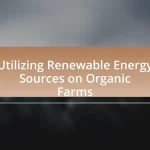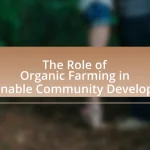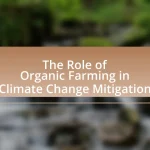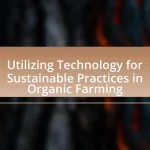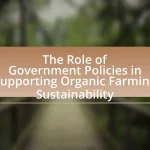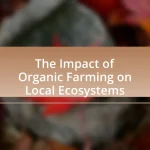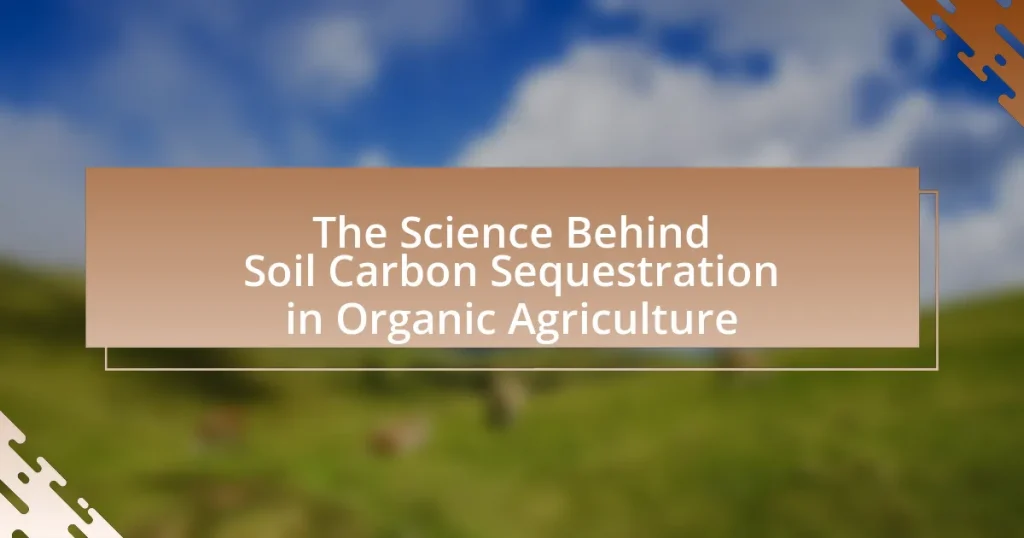Soil carbon sequestration in organic agriculture is the process of capturing and storing atmospheric carbon dioxide in the soil through organic farming practices, significantly enhancing soil organic matter. This article explores how practices such as cover cropping, reduced tillage, and compost application contribute to increased soil carbon stocks, which can be 30% to 50% higher than conventional methods. It also examines the biological processes involved, the environmental importance of soil carbon in mitigating climate change, and the challenges faced by farmers in implementing effective carbon sequestration strategies. Additionally, the article highlights key practices, innovative technologies, and available resources that can aid farmers in maximizing soil carbon storage.
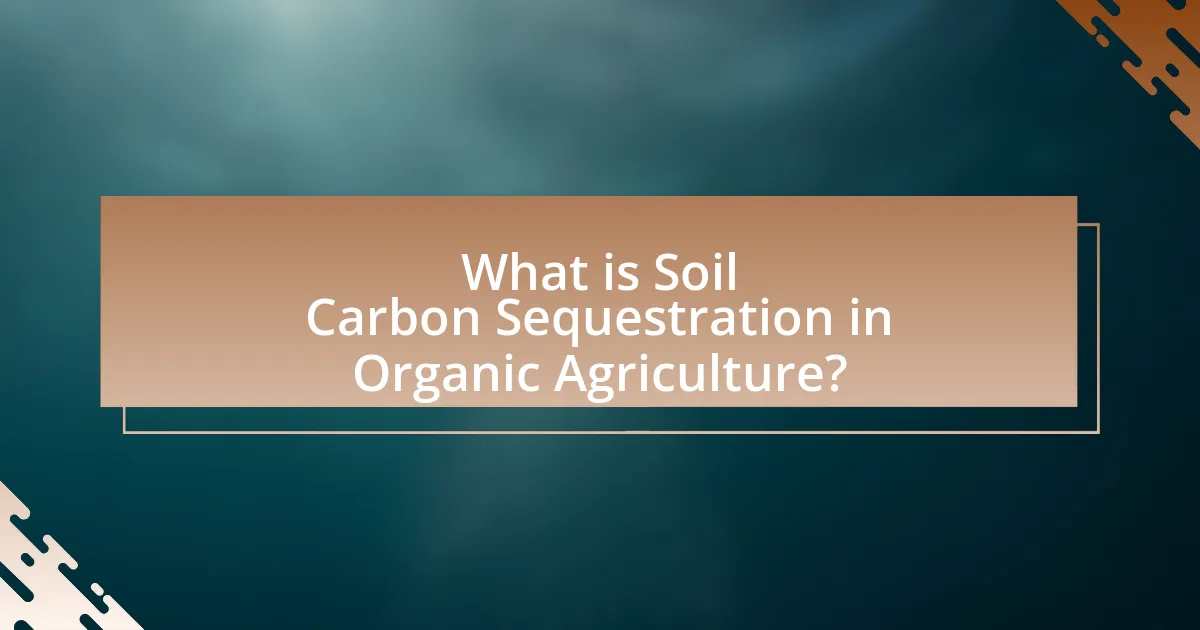
What is Soil Carbon Sequestration in Organic Agriculture?
Soil carbon sequestration in organic agriculture refers to the process of capturing and storing atmospheric carbon dioxide in the soil through organic farming practices. This occurs primarily through the enhancement of soil organic matter, which is achieved by incorporating organic materials such as compost, cover crops, and reduced tillage. Research indicates that organic farming can increase soil carbon stocks by 30% to 50% compared to conventional farming methods, as demonstrated in studies published in the journal “Agriculture, Ecosystems & Environment” by authors such as Reganold and Wachter. This process not only mitigates climate change by reducing greenhouse gases but also improves soil health and fertility.
How does soil carbon sequestration occur in organic farming systems?
Soil carbon sequestration in organic farming systems occurs primarily through the incorporation of organic matter, such as compost and cover crops, which enhances soil structure and microbial activity. This process increases the soil’s capacity to store carbon by promoting the formation of stable organic carbon compounds, known as humus. Research indicates that organic farming practices can lead to a significant increase in soil organic carbon levels, with studies showing that organic soils can store up to 30% more carbon than conventional soils. This enhanced carbon storage is attributed to practices like reduced tillage, crop rotation, and the use of organic fertilizers, which collectively improve soil health and biodiversity, further facilitating carbon sequestration.
What biological processes contribute to soil carbon sequestration?
Soil carbon sequestration is primarily contributed to by biological processes such as photosynthesis, microbial decomposition, and root biomass accumulation. During photosynthesis, plants convert atmospheric carbon dioxide into organic matter, which is then transferred to the soil through root exudates and decaying plant material. Microbial decomposition involves soil microorganisms breaking down organic matter, which releases carbon back into the soil in stable forms like humus. Additionally, root biomass accumulation enhances soil structure and promotes further carbon storage by providing a continuous source of organic material. These processes collectively enhance soil organic carbon levels, which is crucial for soil health and climate regulation.
How do organic practices enhance carbon storage in soil?
Organic practices enhance carbon storage in soil by increasing organic matter content and improving soil structure. These practices, such as cover cropping, crop rotation, and reduced tillage, promote the accumulation of organic materials, which are essential for carbon sequestration. Research indicates that organic farming systems can store up to 30% more carbon in the soil compared to conventional systems due to the enhanced microbial activity and root biomass associated with organic methods. Additionally, a study published in “Agriculture, Ecosystems & Environment” by Reganold and Wachter (2016) found that organic soils have higher levels of soil organic carbon, demonstrating the effectiveness of these practices in enhancing carbon storage.
Why is soil carbon sequestration important for the environment?
Soil carbon sequestration is important for the environment because it mitigates climate change by capturing and storing atmospheric carbon dioxide in the soil. This process enhances soil health, improves water retention, and increases agricultural productivity. According to the Intergovernmental Panel on Climate Change (IPCC), soil carbon sequestration can potentially offset up to 1.1 gigatons of carbon dioxide emissions annually, highlighting its significant role in reducing greenhouse gases and promoting sustainable land management practices.
What role does soil carbon play in mitigating climate change?
Soil carbon plays a crucial role in mitigating climate change by sequestering carbon dioxide from the atmosphere, thereby reducing greenhouse gas concentrations. When organic matter decomposes in soil, it transforms into stable forms of carbon, which can remain stored for decades to centuries. Research indicates that healthy soils can sequester significant amounts of carbon; for instance, a study published in “Nature” by Paustian et al. (2016) estimates that improving soil management practices could sequester up to 1.1 to 2.6 gigatons of carbon dioxide annually. This process not only helps in climate change mitigation but also enhances soil fertility and water retention, creating a more resilient agricultural system.
How does soil carbon sequestration improve soil health and fertility?
Soil carbon sequestration improves soil health and fertility by enhancing soil structure, increasing nutrient availability, and promoting microbial activity. The accumulation of organic carbon in the soil leads to the formation of stable aggregates, which improves aeration and water retention. Research indicates that soils rich in organic carbon can hold up to 20% more water, which is crucial for plant growth. Additionally, higher organic matter levels increase the availability of essential nutrients such as nitrogen, phosphorus, and potassium, thereby supporting plant development. Furthermore, a diverse microbial community thrives in carbon-rich soils, which aids in nutrient cycling and disease suppression, ultimately leading to healthier crops and improved yields.
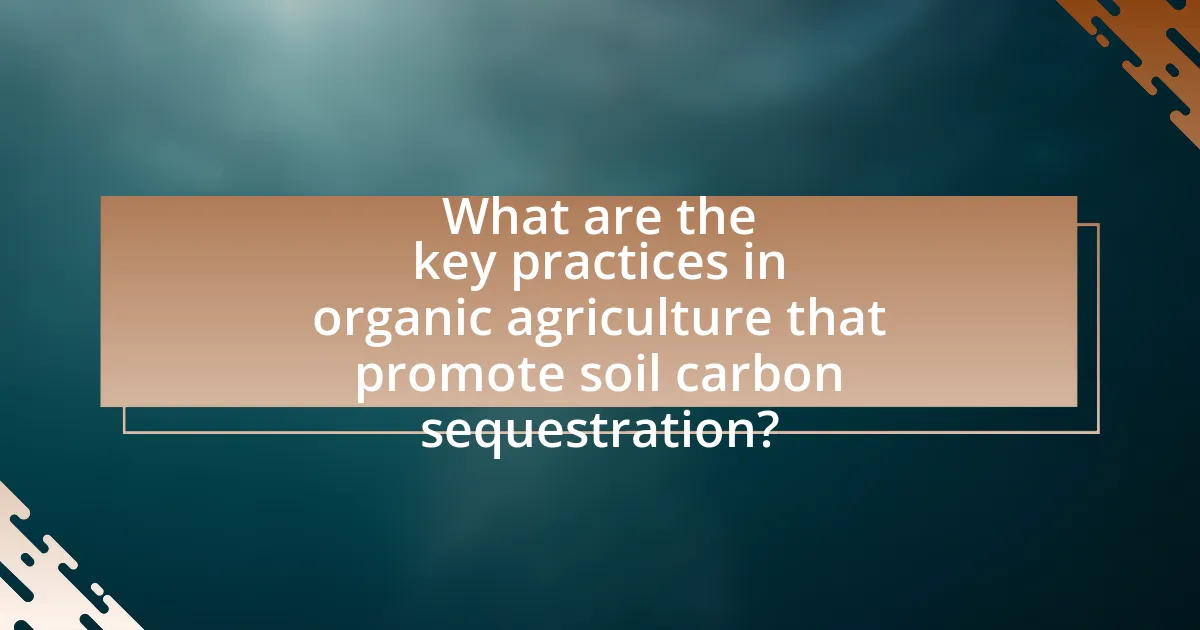
What are the key practices in organic agriculture that promote soil carbon sequestration?
Key practices in organic agriculture that promote soil carbon sequestration include cover cropping, reduced tillage, compost application, and crop rotation. Cover cropping enhances soil organic matter and prevents erosion, which contributes to carbon storage. Reduced tillage minimizes soil disturbance, preserving soil structure and microbial communities that aid in carbon retention. Compost application enriches soil with organic matter, increasing its carbon content. Crop rotation diversifies plant roots and enhances soil health, further supporting carbon sequestration. These practices collectively improve soil fertility and resilience, leading to increased carbon storage in agricultural systems.
How does crop rotation influence soil carbon levels?
Crop rotation enhances soil carbon levels by promoting diverse root structures and microbial activity, which contribute to organic matter accumulation. Different crops have varying root depths and types, allowing for improved soil structure and increased carbon sequestration. Research indicates that fields with diverse crop rotations can store up to 30% more soil organic carbon compared to monoculture systems, as demonstrated in studies by the USDA Agricultural Research Service. This increase in soil carbon is attributed to the enhanced biomass input and reduced soil erosion associated with crop diversity.
What specific crops are most effective for enhancing soil carbon?
Leguminous crops, such as clover, alfalfa, and soybeans, are most effective for enhancing soil carbon. These crops contribute to soil carbon sequestration through their ability to fix atmospheric nitrogen, which promotes soil fertility and microbial activity. Research indicates that leguminous cover crops can increase soil organic carbon levels significantly, with studies showing increases of up to 1.5 tons of carbon per hectare annually when integrated into crop rotations. Additionally, deep-rooted perennials like switchgrass and miscanthus also enhance soil carbon by improving soil structure and stability, further supporting carbon storage in the soil.
How does the timing of crop rotation affect carbon sequestration?
The timing of crop rotation significantly influences carbon sequestration by affecting soil organic matter levels and microbial activity. When crops are rotated at optimal times, it enhances soil structure and promotes the growth of diverse root systems, which contribute to increased organic carbon inputs. Research indicates that well-timed rotations can lead to a 20-30% increase in soil carbon stocks compared to continuous cropping systems, as demonstrated in studies conducted by the USDA Agricultural Research Service. These findings highlight the importance of strategic timing in crop rotation for maximizing carbon sequestration in agricultural soils.
What role do cover crops play in soil carbon sequestration?
Cover crops play a significant role in soil carbon sequestration by enhancing organic matter accumulation in the soil. These crops, such as legumes and grasses, contribute to carbon storage through root biomass and decaying plant material, which increases soil organic carbon levels. Research indicates that cover crops can increase soil organic carbon by 0.1 to 0.5 tons per hectare annually, depending on the species and management practices employed. This process not only sequesters carbon but also improves soil structure, fertility, and resilience against erosion, thereby supporting sustainable agricultural practices.
Which cover crops are best suited for carbon sequestration?
Leguminous cover crops, such as clover and vetch, are best suited for carbon sequestration due to their ability to fix atmospheric nitrogen and enhance soil organic matter. Research indicates that these crops can significantly increase soil carbon levels; for instance, a study published in the journal “Agriculture, Ecosystems & Environment” found that leguminous cover crops can improve soil carbon stocks by up to 1.5 tons per hectare annually. Additionally, deep-rooted cover crops like radishes and turnips contribute to carbon sequestration by improving soil structure and promoting microbial activity, further enhancing carbon storage in the soil.
How do cover crops impact soil microbial activity?
Cover crops significantly enhance soil microbial activity by providing organic matter and nutrients that stimulate microbial growth. The presence of cover crops increases the diversity and abundance of soil microorganisms, which play crucial roles in nutrient cycling and soil health. Research indicates that cover crops can increase microbial biomass by 20-50% compared to bare soil, as they contribute to improved soil structure and moisture retention, creating a more favorable environment for microbial communities. Additionally, studies have shown that specific cover crops, such as legumes, can fix atmospheric nitrogen, further enriching the soil and promoting microbial activity.
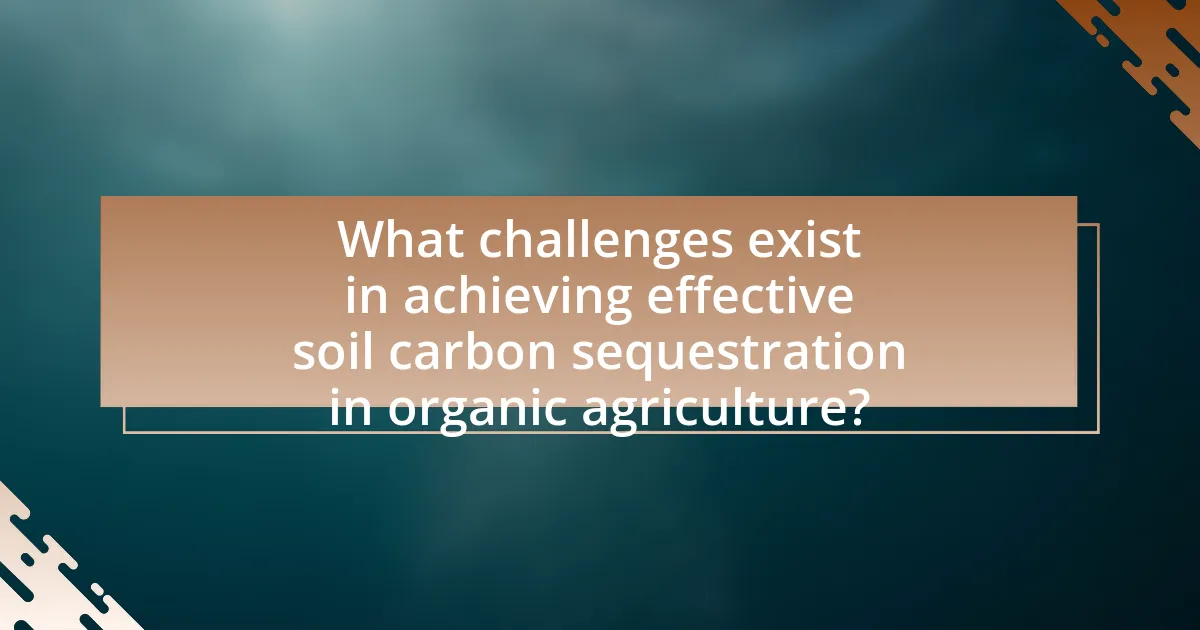
What challenges exist in achieving effective soil carbon sequestration in organic agriculture?
Achieving effective soil carbon sequestration in organic agriculture faces several challenges, including limited knowledge of optimal practices, variability in soil types, and economic constraints. Limited research on specific organic practices hinders farmers’ ability to implement effective carbon sequestration strategies, as evidenced by a study published in “Agriculture, Ecosystems & Environment” which highlights the need for more targeted research (Smith et al., 2020). Additionally, the inherent variability in soil properties across different regions affects the capacity for carbon storage, making it difficult to apply a one-size-fits-all approach. Economic constraints also play a significant role, as organic farmers may lack the financial resources to invest in practices that enhance soil carbon sequestration, such as cover cropping or reduced tillage. These factors collectively impede the progress towards effective soil carbon sequestration in organic agriculture.
What are the limitations of current organic farming practices regarding carbon sequestration?
Current organic farming practices face several limitations regarding carbon sequestration, primarily due to lower soil organic matter accumulation and limited use of cover crops. Organic farming often relies on crop rotations and organic amendments, which can enhance soil health but may not always lead to significant increases in carbon storage compared to conventional methods. Research indicates that organic systems typically sequester less carbon in the soil, with studies showing that organic farms can store approximately 10-20% less carbon than conventional farms under similar conditions. Additionally, the reliance on tillage in some organic practices can lead to soil disturbance, releasing stored carbon back into the atmosphere. These factors collectively hinder the potential of organic farming to maximize carbon sequestration effectively.
How do economic factors influence the adoption of carbon-sequestering practices?
Economic factors significantly influence the adoption of carbon-sequestering practices by determining the financial viability and incentives for farmers. For instance, the cost of implementing such practices, including investments in technology and changes in farming methods, can deter adoption if farmers do not perceive a clear economic benefit. Additionally, government subsidies and carbon credit markets can provide financial incentives that encourage farmers to adopt these practices. Research indicates that regions with strong financial support for sustainable practices see higher rates of adoption; for example, a study by the World Bank found that financial incentives can increase the likelihood of adopting carbon-sequestering practices by up to 30%. Thus, economic factors play a crucial role in shaping the decisions of farmers regarding carbon sequestration in organic agriculture.
What barriers do farmers face in implementing these practices?
Farmers face several barriers in implementing soil carbon sequestration practices in organic agriculture, primarily including financial constraints, lack of knowledge, and limited access to resources. Financial constraints arise from the initial investment required for practices such as cover cropping and reduced tillage, which can be prohibitive for many farmers. A study by the Food and Agriculture Organization indicates that the transition to organic practices often requires significant upfront costs, which can deter farmers from adopting these methods. Additionally, a lack of knowledge about the benefits and techniques of soil carbon sequestration can hinder implementation, as many farmers may not be aware of how to effectively manage their soil for carbon storage. Furthermore, limited access to necessary resources, such as quality organic inputs and technical support, can impede farmers’ ability to adopt these practices successfully.
How can technology aid in enhancing soil carbon sequestration?
Technology can enhance soil carbon sequestration through precision agriculture, remote sensing, and soil management software. Precision agriculture utilizes data analytics and GPS technology to optimize planting and fertilization, which can increase organic matter in the soil, thereby enhancing carbon storage. Remote sensing technologies, such as satellite imagery, allow for the monitoring of soil health and vegetation cover, enabling farmers to implement practices that improve carbon sequestration. Additionally, soil management software can analyze soil composition and recommend practices like cover cropping and reduced tillage, both of which have been shown to increase soil carbon levels significantly. For instance, studies indicate that cover cropping can increase soil organic carbon by up to 1.5 tons per hectare annually.
What innovative tools are available for measuring soil carbon levels?
Innovative tools for measuring soil carbon levels include near-infrared spectroscopy (NIRS), laser-induced breakdown spectroscopy (LIBS), and soil carbon sensors. NIRS allows for rapid, non-destructive analysis of soil samples, providing estimates of organic carbon content based on spectral data. LIBS offers high-resolution elemental analysis, enabling precise measurements of carbon and other soil constituents. Soil carbon sensors, such as those developed by companies like SoilOptix, utilize electromagnetic induction to assess soil carbon levels in situ, providing real-time data for land management. These tools enhance the accuracy and efficiency of soil carbon measurement, supporting better decision-making in organic agriculture.
How can data analytics improve carbon management in organic farming?
Data analytics can improve carbon management in organic farming by enabling precise monitoring and optimization of soil health and carbon sequestration practices. By analyzing data from soil sensors, weather patterns, and crop yields, farmers can make informed decisions that enhance soil organic matter and reduce carbon emissions. For instance, a study published in the journal “Agricultural Systems” found that data-driven approaches can increase soil carbon stocks by up to 30% through targeted interventions such as cover cropping and reduced tillage. This evidence demonstrates that leveraging data analytics leads to more effective carbon management strategies in organic farming.
What are the best practices for farmers to maximize soil carbon sequestration?
Farmers can maximize soil carbon sequestration by implementing practices such as cover cropping, reduced tillage, and organic amendments. Cover cropping enhances soil organic matter and promotes microbial activity, which are essential for carbon storage. Reduced tillage minimizes soil disturbance, preserving soil structure and preventing carbon loss. Additionally, applying organic amendments like compost or manure increases soil fertility and carbon content. Research indicates that these practices can significantly enhance soil carbon levels, with studies showing that cover crops can increase soil organic carbon by up to 1.5 tons per hectare annually.
How can farmers effectively implement organic practices for carbon storage?
Farmers can effectively implement organic practices for carbon storage by adopting techniques such as cover cropping, reduced tillage, and compost application. Cover cropping enhances soil structure and increases organic matter, which can sequester carbon; studies show that cover crops can increase soil organic carbon levels by up to 1.5 tons per hectare annually. Reduced tillage minimizes soil disturbance, preserving existing carbon stocks and promoting microbial activity that contributes to carbon storage. Additionally, applying compost enriches soil with organic matter, which has been shown to improve carbon sequestration rates significantly, with some research indicating increases of 0.5 to 1.0 tons of carbon per hectare per year. These practices collectively enhance soil health and contribute to long-term carbon storage in agricultural systems.
What resources are available for farmers seeking to improve soil carbon sequestration?
Farmers seeking to improve soil carbon sequestration can access various resources, including government programs, research institutions, and agricultural organizations. The USDA’s Natural Resources Conservation Service offers technical and financial assistance through programs like the Conservation Stewardship Program, which incentivizes practices that enhance soil health and carbon storage. Additionally, universities and agricultural extension services provide research-based guidelines and workshops on practices such as cover cropping, reduced tillage, and agroforestry, which have been shown to increase soil organic carbon levels. Studies indicate that implementing these practices can lead to significant carbon sequestration, with potential increases of 0.4 to 1.2 metric tons of carbon per hectare annually, depending on the method and local conditions.
